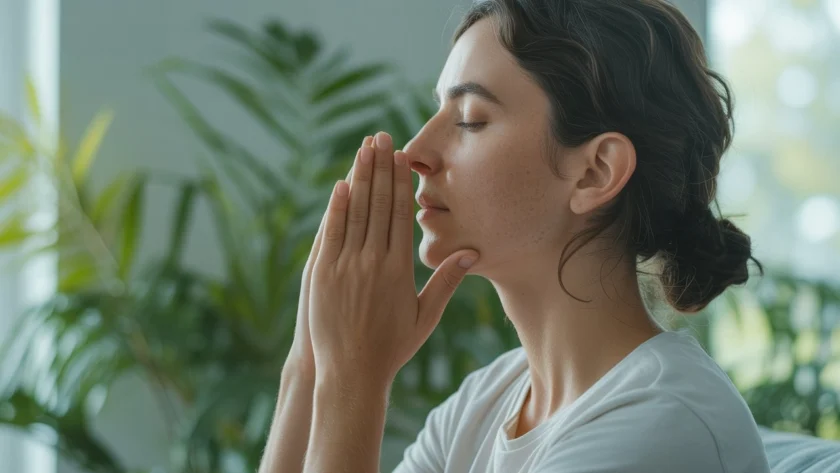You know that moment when anxiety hits and suddenly you can’t seem to catch your breath? I remember sitting in my car outside Target one afternoon, heart racing, feeling like the air around me had turned thick as honey. My chest felt tight, my breathing shallow and rapid, and panic was creeping in fast. That’s when I remembered something my Christian counselor had taught me about breathing—not just as a coping mechanism, but as a way to connect with the breath of life that God gave us.
If you’re living with General Anxiety Disorder, you’ve probably experienced that suffocating feeling more times than you’d like to count. Here’s what I’ve come to understand after years of walking this journey: breathing exercises aren’t just some trendy wellness technique. They’re actually one of the most powerful tools we have for calming our nervous system and finding peace in the storm of anxiety. And when we approach them through the lens of faith, they become even more meaningful.
Understanding the Connection Between Breathing and Anxiety
Let me share something that completely changed how I viewed my anxiety symptoms. When our minds perceive threat—whether real or imagined—our bodies automatically shift into what’s called the “fight or flight” response. Your breathing becomes shallow and rapid, your heart rate increases, and stress hormones flood your system. It’s like your body is preparing to run from a lion, except the lion is often just worry about tomorrow’s meeting or next month’s bills.
I’ve learned that General Anxiety Disorder essentially keeps our nervous system stuck in this heightened state. Our breath becomes our enemy instead of our ally, creating a cycle where shallow breathing feeds more anxiety, which creates more shallow breathing. But here’s the beautiful thing—we can interrupt this cycle.
When we slow down and deepen our breathing, we’re essentially telling our nervous system, “Hey, it’s okay. We’re safe.” It’s like sending a gentle message to every cell in our body that we can rest. There’s something profound about this that speaks to how God designed us—our breath as a pathway back to peace.

The Spiritual Significance of Breath in Managing Anxiety
Now, I know what you might be thinking—breathing exercises sound pretty secular, right? But as I’ve deepened my faith journey, I’ve discovered something incredible about breath in scripture. The Hebrew word “ruach” means both breath and spirit. When God breathed into Adam the breath of life, He was giving him both physical breath and spiritual life.
Every time we practice intentional breathing, we’re participating in something sacred. We’re acknowledging that our breath is a gift from our Creator, and we’re choosing to use that gift to find the peace He promises us. Jesus himself tells us in Matthew 6:26 to look at the birds of the air—they don’t worry about tomorrow, yet our heavenly Father feeds them. When we breathe deeply and slowly, we’re practicing that same trust.
I’ve found that approaching breathing exercises as a form of prayer transforms the entire experience. Instead of just trying to calm down, I’m connecting with the One who holds my future and knows every anxious thought before I even think it.
Simple Breathing Techniques That Actually Work
Over the years, I’ve tried countless breathing exercises, and I want to share the ones that have genuinely helped me manage my General Anxiety Disorder symptoms. These aren’t complicated techniques that require perfect execution—they’re simple practices you can do anywhere, anytime anxiety tries to steal your peace.
The 4-7-8 Breathing Method
This technique has been my go-to during panic attacks. Here’s how it works: breathe in through your nose for 4 counts, hold your breath for 7 counts, then exhale slowly through your mouth for 8 counts. I like to think of it as breathing in God’s peace, holding it close to my heart, and releasing all my worries.
The beauty of this method is that the extended exhale activates your parasympathetic nervous system—the part responsible for rest and relaxation. I’ve used this technique in church parking lots, before difficult conversations, and even at 3 AM when anxiety decides to throw a party in my mind.
Box Breathing for Grounding
Box breathing is wonderfully simple: breathe in for 4 counts, hold for 4, exhale for 4, hold for 4. Picture drawing a box with your breath. This technique has helped me countless times when my thoughts start racing and I need to feel grounded again.
What I love about box breathing is how it gives your mind something concrete to focus on. Instead of spiraling into “what if” thoughts, you’re concentrating on something immediate and manageable. Sometimes I’ll pray the words “God is good” on the inhale and “all the time” on the exhale, turning the exercise into worship.
Belly Breathing for Deep Relaxation
This one took me a while to master because anxiety had trained me to breathe up in my chest. Belly breathing involves placing one hand on your chest and one on your belly, then breathing so that only your bottom hand moves. It feels awkward at first, but it’s incredibly effective for managing General Anxiety Disorder symptoms.
I practice this technique every morning with my coffee, often while reading scripture. It’s become a sacred time where I literally breathe in God’s promises and prepare my nervous system for whatever the day might bring. Bailey, my rescue dog, has learned that this is quiet time—he’ll come sit beside me like he knows I need the companionship.
Creating a Daily Breathing Practice
Here’s what I wish someone had told me when I first started using breathing exercises for anxiety: consistency matters more than perfection. You don’t need to breathe perfectly or find instant calm every time. What you need is to show up regularly and trust the process.
I’ve found that starting small is key. Begin with just five minutes of intentional breathing each day. Maybe it’s when you first wake up, before you check your phone and let the world rush in. Or perhaps it’s during your lunch break, creating a pocket of peace in your busy day. The timing matters less than the commitment to showing up.
What’s helped me most is connecting my breathing practice to my prayer life. Sometimes I breathe through the Lord’s Prayer, using each phrase to guide my inhale and exhale. Other times I simply breathe in the word “peace” and exhale the word “worry.” It’s amazing how this simple practice can shift my entire perspective on challenging days.
When Anxiety Symptoms Feel Overwhelming
Let me be honest with you—there are days when breathing exercises feel impossible. When panic attacks hit hard, when your chest feels tight, and when every breath seems like a struggle, it’s easy to think these techniques don’t work. I’ve been there, friend. I’ve sat on my bathroom floor at 2 AM, trying to breathe deeply while feeling like I was drowning in my own anxiety.
During these intense moments, I’ve learned to simplify everything. Instead of complex breathing patterns, I focus on just slowing down my exhale. Even if I can’t control my racing thoughts, I can make my out-breath a little longer than my in-breath. It’s not about perfection—it’s about progress, one breath at a time.
I also remind myself of Psalm 34:18: “The Lord is close to the brokenhearted and saves those who are crushed in spirit.” When anxiety feels crushing, God is not distant. He’s right there in the struggle, and my breath is a bridge back to His presence.
The Science Behind Why These Methods Help General Anxiety Disorder
Now, I’m not a scientist, but I’ve learned enough about anxiety to understand why these techniques actually work. When we breathe slowly and deeply, we’re stimulating the vagus nerve—essentially the “rest and digest” pathway in our nervous system. This sends signals to our brain that we’re safe, which helps reduce the production of stress hormones like cortisol and adrenaline.
For those of us with General Anxiety Disorder, this is particularly important because our nervous systems tend to be hypervigilant, constantly scanning for threats. Breathing exercises help retrain our system to find balance again. It’s like teaching an overprotective guard dog to relax—it takes time and consistency, but it’s absolutely possible.
What fascinates me is how God designed our bodies with built-in mechanisms for peace. We don’t need external substances or complicated procedures. We literally carry the tools for calm within us every moment of every day.
Combining Breathing Exercises with Faith-Based Practices
This is where breathing exercises become truly transformative for Christian anxiety sufferers. When we combine these techniques with prayer, scripture meditation, and worship, we’re addressing anxiety on multiple levels—physical, emotional, and spiritual.
One practice that’s revolutionized my anxiety management is praying scripture while breathing intentionally. I’ll breathe in while thinking “Cast all your anxiety on Him” and exhale while focusing on “because He cares for you” from 1 Peter 5:7. This isn’t just positive thinking—it’s allowing God’s truth to literally fill my lungs and flow through my bloodstream.
I’ve also found that listening to worship music while practicing breathing exercises creates a powerful combination. There’s something about melodies that praise God mixed with intentional breathing that seems to unlock deeper peace. My anxiety starts to feel less overwhelming when I’m surrounded by reminders of God’s goodness and faithfulness.
Practical Tips for Making Breathing Exercises Work Long-term
After years of using breathing techniques to manage my General Anxiety Disorder, I’ve learned some practical strategies that make all the difference. First, don’t wait until you’re in crisis to practice. Build these exercises into your routine when you’re relatively calm, so they’re second nature when anxiety strikes.
I keep breathing exercise reminders in strategic places—a note on my bathroom mirror, a reminder on my phone, even a small card in my purse. When anxiety starts creeping in, these visual cues help me remember I have tools available. It’s like having a first aid kit for my nervous system.
Another game-changer has been practicing breathing exercises with my church community. We’ve started incorporating brief breathing prayers into our small group meetings, and it’s beautiful to see how collective intentional breathing creates such a sense of peace and unity. There’s power in breathing together, just like there’s power in praying together.
Building Your Personal Breathing Toolkit
Every person’s experience with anxiety is unique, and what works for me might need tweaking to work for you. That’s perfectly okay. I encourage you to experiment with different breathing techniques and find the ones that resonate with your spirit and calm your nervous system.
Start a simple breathing journal—just a few notes about which techniques you tried, how you felt before and after, and any insights or prayers that came up during the practice. This isn’t about being perfect or scientific; it’s about paying attention to how God might be using these tools to bring healing to your anxious heart.
Remember, building new habits takes time. Be patient with yourself as you develop your breathing practice. Some days will feel more successful than others, and that’s completely normal. Progress in managing General Anxiety Disorder isn’t linear—it’s a journey with ups and downs, and every small step matters.
Finding Peace One Breath at a Time
As I write this, I’m sitting in my garden with Bailey at my feet, practicing the same breathing techniques that have carried me through countless anxious moments over the years. The morning sun is streaming through the trees, birds are singing their praise songs, and I’m breathing in the reality that God’s mercies are new every morning.
If you’re struggling with General Anxiety Disorder today, please know that you’re not alone, and you’re not stuck. Your breath is a gift from God, and it can become a pathway to the peace He promises. These breathing exercises aren’t magic formulas, but they are practical tools that can help retrain your nervous system and create space for God’s comfort to reach your heart.
Start small, be patient with yourself, and remember that every conscious breath you take is an act of faith. You’re choosing to trust that peace is possible, that your body can learn to rest, and that the God who gave you breath will also give you strength to face each day.
The next time anxiety tries to steal your peace, remember: you have everything you need right within you. Take a deep breath, whisper a prayer, and trust that the One who holds your future is also holding you right now, breath by breath.




